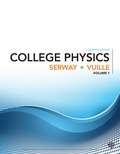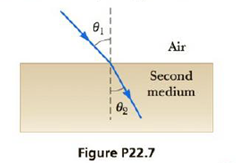
EBK COLLEGE PHYSICS, VOLUME 1
11th Edition
ISBN: 8220103599986
Author: Vuille
Publisher: Cengage Learning US
expand_more
expand_more
format_list_bulleted
Concept explainers
Textbook Question
Chapter 22, Problem 7P
A ray of light travels from air into another medium, making an angle of θ1 = 45.0° with the normal as in Figure P22.7. Find the angle of refraction θ2 if the second medium is (a) fused quartz, (b) carbon disulfide, and (c) water.

Expert Solution & Answer
Want to see the full answer?
Check out a sample textbook solution
Students have asked these similar questions
Hi,
I have canceled, why did you charge me again?
No chatgpt pls will upvote
No chatgpt pls will upvote
Chapter 22 Solutions
EBK COLLEGE PHYSICS, VOLUME 1
Ch. 22.2 - Which part of Figure 22.3, (a) or (b), better...Ch. 22.2 - Prob. 22.2QQCh. 22.3 - A material has an index of refraction that...Ch. 22.3 - As light travels from a vacuum (n = 1) to a medium...Ch. 22 - Prob. 1CQCh. 22 - A ray of light passes from one material into a...Ch. 22 - Prob. 3CQCh. 22 - Prob. 4CQCh. 22 - Determine whether each of the following statements...Ch. 22 - A type of mirage called a pingo is often observed...
Ch. 22 - In dispersive materials, the angle of refraction...Ch. 22 - The level of water in a clear, colorless glass can...Ch. 22 - Prob. 9CQCh. 22 - Light in medium A undergoes a total internal...Ch. 22 - Prob. 11CQCh. 22 - Try this simple experiment on your own. Take two...Ch. 22 - Prob. 13CQCh. 22 - Prob. 14CQCh. 22 - A light ray containing both blue and red...Ch. 22 - During the Apollo XI Moon landing, a...Ch. 22 - Prob. 2PCh. 22 - Prob. 3PCh. 22 - Prob. 4PCh. 22 - Prob. 5PCh. 22 - Find the speed of light in (a) water, (b) crown...Ch. 22 - A ray of light travels from air into another...Ch. 22 - Prob. 8PCh. 22 - An underwater scuba diver sees the Sun at an...Ch. 22 - Prob. 10PCh. 22 - A laser beam is incident at an angle of 30.0 to...Ch. 22 - Light containing wavelengths of 400. nm, 500. nm,...Ch. 22 - A ray of light is incident on the surface of a...Ch. 22 - Prob. 14PCh. 22 - The light emitted by a helium-neon laser has a...Ch. 22 - Figure P22.16 shows a light ray traveling in a...Ch. 22 - Prob. 17PCh. 22 - A ray of light strikes a flat, 2.00-cm-thick block...Ch. 22 - Prob. 19PCh. 22 - Prob. 20PCh. 22 - A man shines a flashlight from a boat into the...Ch. 22 - A narrow beam of ultra-sonic waves reflects off...Ch. 22 - A person looking into an empty container is able...Ch. 22 - Prob. 24PCh. 22 - Prob. 25PCh. 22 - Prob. 26PCh. 22 - An opaque cylindrical tank with an open top has a...Ch. 22 - A certain kind of glass has an index of refraction...Ch. 22 - The index of refraction for red light in water is...Ch. 22 - The index of refraction for crown glass is 1.512...Ch. 22 - A light beam containing red and violet wavelengths...Ch. 22 - Prob. 32PCh. 22 - A ray of light strikes the midpoint of one face of...Ch. 22 - For light of wavelength 589 nm. calculate the...Ch. 22 - Repeat Problem 34, but this time assume the...Ch. 22 - A beam of light is incident from air on the...Ch. 22 - Prob. 37PCh. 22 - Prob. 38PCh. 22 - A light ray is incident normally to the long face...Ch. 22 - Prob. 40PCh. 22 - A room contains air in which the speed of sound is...Ch. 22 - Prob. 42PCh. 22 - The light beam in Figure P22.43 strikes surface 2...Ch. 22 - Prob. 44PCh. 22 - A layer of ice having parallel sides floats on...Ch. 22 - A ray of light is incident at an angle 30.0 on a...Ch. 22 - When a man stands near the edge of an empty...Ch. 22 - Prob. 48APCh. 22 - Refraction causes objects submerged in water to...Ch. 22 - A narrow beam of light is incident from air onto a...Ch. 22 - Prob. 51APCh. 22 - Endoscopes are medical instruments used to examine...Ch. 22 - A piece of wire is bent through an angle . The...Ch. 22 - Prob. 54APCh. 22 - Prob. 55APCh. 22 - Prob. 56APCh. 22 - Prob. 57APCh. 22 - Students allow a narrow beam of laser light to...Ch. 22 - Prob. 59APCh. 22 - Three sheets of plastic have unknown indices of...Ch. 22 - A person swimming underwater on a bright day and...Ch. 22 - Prob. 62AP
Knowledge Booster
Learn more about
Need a deep-dive on the concept behind this application? Look no further. Learn more about this topic, physics and related others by exploring similar questions and additional content below.Similar questions
- No chatgpt pls will upvotearrow_forwardYou are standing a distance x = 1.75 m away from this mirror. The object you are looking at is y = 0.29 m from the mirror. The angle of incidence is θ = 30°. What is the exact distance from you to the image?arrow_forwardFor each of the actions depicted below, a magnet and/or metal loop moves with velocity v→ (v→ is constant and has the same magnitude in all parts). Determine whether a current is induced in the metal loop. If so, indicate the direction of the current in the loop, either clockwise or counterclockwise when seen from the right of the loop. The axis of the magnet is lined up with the center of the loop. For the action depicted in (Figure 5), indicate the direction of the induced current in the loop (clockwise, counterclockwise or zero, when seen from the right of the loop). I know that the current is clockwise, I just dont understand why. Please fully explain why it's clockwise, Thank youarrow_forward
- A planar double pendulum consists of two point masses \[m_1 = 1.00~\mathrm{kg}, \qquad m_2 = 1.00~\mathrm{kg}\]connected by massless, rigid rods of lengths \[L_1 = 1.00~\mathrm{m}, \qquad L_2 = 1.20~\mathrm{m}.\]The upper rod is hinged to a fixed pivot; gravity acts vertically downward with\[g = 9.81~\mathrm{m\,s^{-2}}.\]Define the generalized coordinates \(\theta_1,\theta_2\) as the angles each rod makes with thedownward vertical (positive anticlockwise, measured in radians unless stated otherwise).At \(t=0\) the system is released from rest with \[\theta_1(0)=120^{\circ}, \qquad\theta_2(0)=-10^{\circ}, \qquad\dot{\theta}_1(0)=\dot{\theta}_2(0)=0 .\]Using the exact nonlinear equations of motion (no small-angle or planar-pendulumapproximations) and assuming the rods never stretch or slip, determine the angle\(\theta_2\) at the instant\[t = 10.0~\mathrm{s}.\]Give the result in degrees, in the interval \((-180^{\circ},180^{\circ}]\).arrow_forwardWhat are the expected readings of the ammeter and voltmeter for the circuit in the figure below? (R = 5.60 Ω, ΔV = 6.30 V) ammeter I =arrow_forwardsimple diagram to illustrate the setup for each law- coulombs law and biot savart lawarrow_forward
- A circular coil with 100 turns and a radius of 0.05 m is placed in a magnetic field that changes at auniform rate from 0.2 T to 0.8 T in 0.1 seconds. The plane of the coil is perpendicular to the field.• Calculate the induced electric field in the coil.• Calculate the current density in the coil given its conductivity σ.arrow_forwardAn L-C circuit has an inductance of 0.410 H and a capacitance of 0.250 nF . During the current oscillations, the maximum current in the inductor is 1.80 A . What is the maximum energy Emax stored in the capacitor at any time during the current oscillations? How many times per second does the capacitor contain the amount of energy found in part A? Please show all steps.arrow_forwardA long, straight wire carries a current of 10 A along what we’ll define to the be x-axis. A square loopin the x-y plane with side length 0.1 m is placed near the wire such that its closest side is parallel tothe wire and 0.05 m away.• Calculate the magnetic flux through the loop using Ampere’s law.arrow_forward
- Describe the motion of a charged particle entering a uniform magnetic field at an angle to the fieldlines. Include a diagram showing the velocity vector, magnetic field lines, and the path of the particle.arrow_forwardDiscuss the differences between the Biot-Savart law and Coulomb’s law in terms of their applicationsand the physical quantities they describe.arrow_forwardExplain why Ampere’s law can be used to find the magnetic field inside a solenoid but not outside.arrow_forward
arrow_back_ios
SEE MORE QUESTIONS
arrow_forward_ios
Recommended textbooks for you
 College PhysicsPhysicsISBN:9781285737027Author:Raymond A. Serway, Chris VuillePublisher:Cengage Learning
College PhysicsPhysicsISBN:9781285737027Author:Raymond A. Serway, Chris VuillePublisher:Cengage Learning College PhysicsPhysicsISBN:9781305952300Author:Raymond A. Serway, Chris VuillePublisher:Cengage Learning
College PhysicsPhysicsISBN:9781305952300Author:Raymond A. Serway, Chris VuillePublisher:Cengage Learning Principles of Physics: A Calculus-Based TextPhysicsISBN:9781133104261Author:Raymond A. Serway, John W. JewettPublisher:Cengage Learning
Principles of Physics: A Calculus-Based TextPhysicsISBN:9781133104261Author:Raymond A. Serway, John W. JewettPublisher:Cengage Learning Physics for Scientists and Engineers, Technology ...PhysicsISBN:9781305116399Author:Raymond A. Serway, John W. JewettPublisher:Cengage Learning
Physics for Scientists and Engineers, Technology ...PhysicsISBN:9781305116399Author:Raymond A. Serway, John W. JewettPublisher:Cengage Learning Physics for Scientists and EngineersPhysicsISBN:9781337553278Author:Raymond A. Serway, John W. JewettPublisher:Cengage Learning
Physics for Scientists and EngineersPhysicsISBN:9781337553278Author:Raymond A. Serway, John W. JewettPublisher:Cengage Learning Physics for Scientists and Engineers with Modern ...PhysicsISBN:9781337553292Author:Raymond A. Serway, John W. JewettPublisher:Cengage Learning
Physics for Scientists and Engineers with Modern ...PhysicsISBN:9781337553292Author:Raymond A. Serway, John W. JewettPublisher:Cengage Learning

College Physics
Physics
ISBN:9781285737027
Author:Raymond A. Serway, Chris Vuille
Publisher:Cengage Learning

College Physics
Physics
ISBN:9781305952300
Author:Raymond A. Serway, Chris Vuille
Publisher:Cengage Learning

Principles of Physics: A Calculus-Based Text
Physics
ISBN:9781133104261
Author:Raymond A. Serway, John W. Jewett
Publisher:Cengage Learning

Physics for Scientists and Engineers, Technology ...
Physics
ISBN:9781305116399
Author:Raymond A. Serway, John W. Jewett
Publisher:Cengage Learning

Physics for Scientists and Engineers
Physics
ISBN:9781337553278
Author:Raymond A. Serway, John W. Jewett
Publisher:Cengage Learning

Physics for Scientists and Engineers with Modern ...
Physics
ISBN:9781337553292
Author:Raymond A. Serway, John W. Jewett
Publisher:Cengage Learning
AP Physics 2 - Geometric Optics: Mirrors and Lenses - Intro Lesson; Author: N. German;https://www.youtube.com/watch?v=unT297HdZC0;License: Standard YouTube License, CC-BY